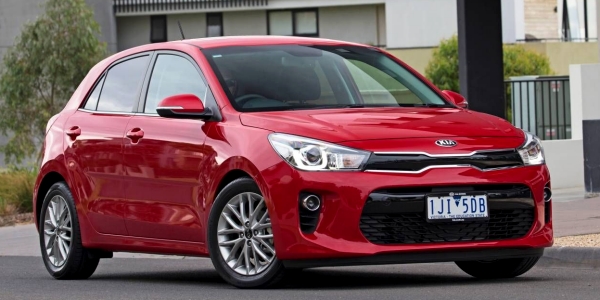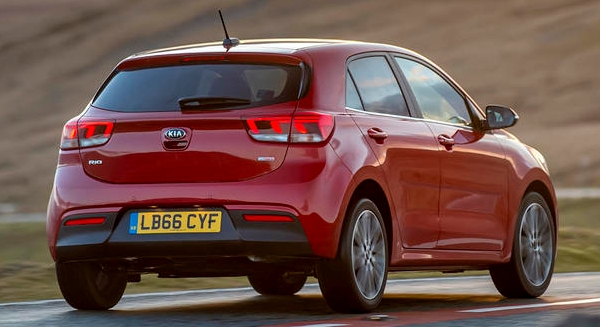Published
on 14
Feb 2017
|
All rights reserved.
|
|
|

|
|
Maybe
Mr. Schreyer spent too much energy on the superb Stinger and had this
one passed over... |
|
In the past 6 or 7 years
Kia and Hyundai have been known for fast-rising design under the lead
of Peter Schreyer. However, recently their new launches become
conservative, replacing avant-garde theme with maturity. The first
victims are Hyundai Sonata, Elantra, i20 and i30. Now the list extends
to Kia Rio (or Pride in Korea).
You know what Rio is. It is the company’s B-segment supermini and the
sister car of Hyundai i20. The last generation (Mk3) Rio was quite
radically styled. Its windscreen and bonnet were so steeply raked that
the body nearly became a monospace. Its rising shoulder line, one-piece
rear side windows and tapered C-pillars contributed to a sporty
appearance. In contrast, the new car looks like a bar of soap. Its body
profile is boxy, just with the edges and corners rounded. Interior
volume should be benefited by such profile, but aesthetic takes a blow.
The windscreen is more upright. The bonnet is flatter. The shoulder
line is more horizontal. At the nose, the bumper intake gets larger and
more rectangular, but the “Tiger nose” grille is strangely covered with
a piece of
lacquered black plastic. What is the calculation behind Peter
Schreyer’s change of direction? I am not sure, but I really doubt if it
is a smart move. Maybe Mr. Schreyer spent too much energy on the superb
Stinger and had this one passed over.

|
|
Mediocre
engines matched with dull chassis means not much fun to drive.
|
|
Inside, the story is slightly better. Generally speaking, the cabin’s
materials, build quality, functions and ergonomics are all improved
from the old car’s, just as you would expect. The 7-inch infotainment
touchscreen is positioned higher to be easier viewing. Its software and
response are also much improved to be very competitive for the class,
while Apple Carplay and Android Auto connectivity are included.
Thankfully, it still leaves hardware switches and dials at the lower
part of center console for controlling air-con etc., so you don’t need
to go through the steps on touchscreen. The dashboard design is hardly
inspiring, as is the dark theme – the color inserts on top-spec trim
fail to lift the ambience much. Hard plastics are found everywhere
except the dash top, while door panels are made of particularly cheap,
scratchy and shiny plastics, so its perceived quality is no match with
Volkswagen Polo, Nissan Micra, Peugeot 208 etc. However, the cabin
plastics are well screwed together, and the switches feel solid.
In terms of practicality, the new Rio is remarkable. Its cabin is large
for the class. The rear seat offers enough space for 2 adults without
compromising the front passengers. Rear legroom is adequate while
headroom is good for 6-footers. Slimmer door panels free up elbow room,
yet the doors incorporate large cubbies for bottle water. Speaking of
storage, there are plenty. There is a two-tier cubby at the center
console, in front of the gearstick to place mobile phones and small
stuffs. At the back, the boot is one of the largest in the class at 325
liters. Only Honda Fit (Jazz) and Skoda Fabia beat it for luggage
carrying capability.
 |
|
Plenty of space
and storage, but the cabin disappoints in style and perceived quality.
|
|
The car shares platform with Hyundai i20, which is also an updated
version of the outgoing car’s underpinnings. Therefore, its dimensions
hardly change – just 15mm longer, 5mm wider, 5mm lower and 10mm longer
in wheelbase. Kia said 51 percent of the monocoque is made of advanced
high-strength steel, i.e. those with tensile strength >550MPa, up
from 33 percent of the old car. This should improve its crash safety
while lightening the chassis a little. Not much else of the chassis is
worth mentioning. In the engine compartment, there is a pair of new
1.0T-GDI three-cylinder direct injection turbo, offering either 100hp
or 120hp. Other engines are carried over but detuned to save fuel:
1.4-liter 16V Gamma (100hp), 1.25-liter 16V Kappa (84hp) and a pair of
1.4CRDi turbo diesel (77 or 90hp). The old car’s 140hp 1.6-liter GDI
has been dropped to cut CO2.
On the road, the 120hp 1.0T engine offers decent power, flexibility and
refinement, but it won’t make you wonder like Ford 1.0 Ecoboost. It
revs smoothly and quietly until 4000rpm, then it becomes noisy and
strained. Fortunately, the 6-speed manual gearbox keeps it at the sweet
zone on highway. With less torque, the naturally aspirated 1.4-liter
feels underpowered, let alone the 1.25-liter. In corners, the Rio
handles its body movement okay but never feels as sharp as Ford Fiesta
or many other European rivals. The steering is quick enough and weighs
up adequately as speed rises, but at no time it communicates with you.
The ride is slightly more composed than the old car’s, but it still
fails to match the class standards. The suspension doesn’t absorb
low-speed bumps in town very well, resulting in a lot of thumps and
noise. As the chassis was tuned primarily in Germany (Australian
version gets its own suspension and steering tuning), it rides better
on
highway. Still, you had better to avoid the 17-inch wheels with
low-profile tires. Meanwhile, there is still too much wind and road
noise at highway speed.
Overall, the Rio is hard to impress. It looks dull, it drives dull and
it is not particularly refined. There seems to be not a single reason
to buy it instead of the countless of good superminis on the market.
Korean magic seems to be fading.
|
Verdict:   |
|